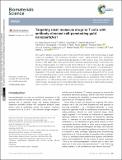| dc.contributor.author | Bekdemir, Ahmet | |
| dc.contributor.author | Watson, Nicki | |
| dc.contributor.author | Ingram, Jessica | |
| dc.contributor.author | Stellacci, Francesco R. | |
| dc.contributor.author | Yang, Yu-Sang Sabrina | |
| dc.contributor.author | Moynihan, Kelly Dare | |
| dc.contributor.author | Dichwalkar, Tanmay M | |
| dc.contributor.author | Noh, Michelle M. | |
| dc.contributor.author | Melo, Mariane Bandeira | |
| dc.contributor.author | Suh, Heikyung | |
| dc.contributor.author | Ploegh, Hidde | |
| dc.contributor.author | Irvine, Darrell J | |
| dc.date.accessioned | 2019-02-04T15:43:27Z | |
| dc.date.available | 2019-02-04T15:43:27Z | |
| dc.date.issued | 2018-11 | |
| dc.date.submitted | 2018-10 | |
| dc.identifier.issn | 2047-4830 | |
| dc.identifier.issn | 2047-4849 | |
| dc.identifier.uri | http://hdl.handle.net/1721.1/120167 | |
| dc.description.abstract | We sought to develop a nanoparticle vehicle that could efficiently deliver small molecule drugs to target lymphocyte populations. The synthesized amphiphilic organic ligand-protected gold nanoparticles (amph-NPs) were capable of sequestering large payloads of small molecule drugs within hydrophobic pockets of their ligand shells. These particles exhibit membrane-penetrating activity in mammalian cells, and thus enhanced uptake of a small molecule TGF-β inhibitor in T cells in cell culture. By conjugating amph-NPs with targeting antibodies or camelid-derived nanobodies, the particles' cell-penetrating properties could be temporarily suppressed, allowing targeted uptake in specific lymphocyte subpopulations. Degradation of the protein targeting moieties following particle endocytosis allowed the NPs to recover their cell-penetrating activity in situ to enter the cytoplasm of T cells. In vivo, targeted amph-NPs showed 40-fold enhanced uptake in CD8+ T cells relative to untargeted particles, and delivery of TGF-β inhibitor-loaded particles to T cells enhanced their cytokine polyfunctionality in a cancer vaccine model. Thus, this system provides a facile approach to concentrate small molecule compounds in target lymphocyte populations of interest for immunotherapy in cancer and other diseases. | en_US |
| dc.description.sponsorship | Massachusetts Institute of Technology. Institute for Soldier Nanotechnologies (Contract W911NF-13-D-0001) | en_US |
| dc.description.sponsorship | Melanoma Research Alliance | en_US |
| dc.description.sponsorship | National Cancer Institute (U.S.) (David H. Koch Institute for Integrative Cancer Research at MIT. (Support (Core) Grant P30-CA14051) | en_US |
| dc.description.sponsorship | National Institutes of Health (U.S.) (Grant CA174795) | en_US |
| dc.description.sponsorship | National Institutes of Health (U.S.) (Grant CA172164) | en_US |
| dc.description.sponsorship | Horizon 2020 Framework Programme (European Commission). FutureNanoNeeds Project | en_US |
| dc.publisher | Royal Society of Chemistry | en_US |
| dc.relation.isversionof | http://dx.doi.org/10.1039/c8bm01208c | en_US |
| dc.rights | Creative Commons Attribution Noncommercial 3.0 unported license | en_US |
| dc.rights.uri | https://creativecommons.org/licenses/by-nc/3.0/ | en_US |
| dc.source | Royal Society of Chemistry (RSC) | en_US |
| dc.title | Targeting small molecule drugs to T cells with antibody-directed cell-penetrating gold nanoparticles | en_US |
| dc.type | Article | en_US |
| dc.identifier.citation | Yang, Yu-Sang Sabrina, Kelly D. Moynihan, Ahmet Bekdemir, Tanmay M. Dichwalkar, Michelle M. Noh, Nicki Watson, Mariane Melo, et al. “Targeting Small Molecule Drugs to T Cells with Antibody-Directed Cell-Penetrating Gold Nanoparticles.” Biomaterials Science 7, no. 1 (2019): 113–124. © The Royal Society of Chemistry | en_US |
| dc.contributor.department | Massachusetts Institute of Technology. Department of Biological Engineering | en_US |
| dc.contributor.department | Massachusetts Institute of Technology. Department of Biology | en_US |
| dc.contributor.department | Massachusetts Institute of Technology. Department of Materials Science and Engineering | en_US |
| dc.contributor.department | Koch Institute for Integrative Cancer Research at MIT | en_US |
| dc.contributor.mitauthor | Yang, Yu-Sang Sabrina | |
| dc.contributor.mitauthor | Moynihan, Kelly Dare | |
| dc.contributor.mitauthor | Dichwalkar, Tanmay M | |
| dc.contributor.mitauthor | Noh, Michelle M. | |
| dc.contributor.mitauthor | Melo, Mariane Bandeira | |
| dc.contributor.mitauthor | Suh, Heikyung | |
| dc.contributor.mitauthor | Ploegh, Hidde | |
| dc.contributor.mitauthor | Irvine, Darrell J | |
| dc.relation.journal | Biomaterials Science | en_US |
| dc.eprint.version | Final published version | en_US |
| dc.type.uri | http://purl.org/eprint/type/JournalArticle | en_US |
| eprint.status | http://purl.org/eprint/status/PeerReviewed | en_US |
| dc.date.updated | 2019-01-17T13:49:03Z | |
| dspace.orderedauthors | Yang, Yu-Sang Sabrina; Moynihan, Kelly D.; Bekdemir, Ahmet; Dichwalkar, Tanmay M.; Noh, Michelle M.; Watson, Nicki; Melo, Mariane; Ingram, Jessica; Suh, Heikyung; Ploegh, Hidde; Stellacci, Francesco R.; Irvine, Darrell J. | en_US |
| dspace.embargo.terms | N | en_US |
| dc.identifier.orcid | https://orcid.org/0000-0003-0787-298X | |
| dc.identifier.orcid | https://orcid.org/0000-0002-1090-6071 | |
| mit.license | PUBLISHER_CC | en_US |
